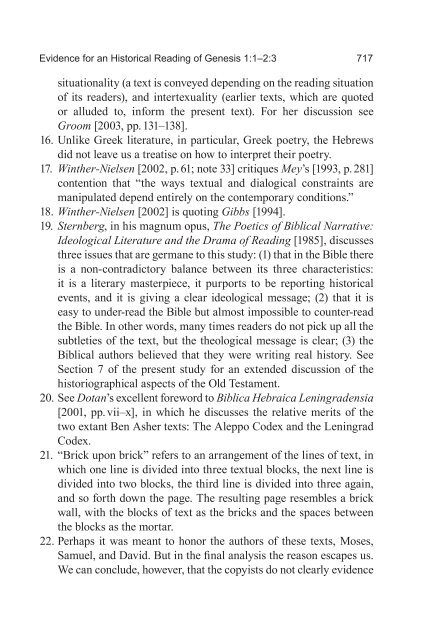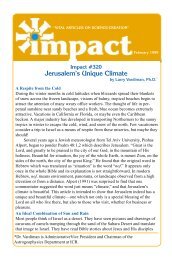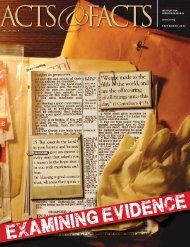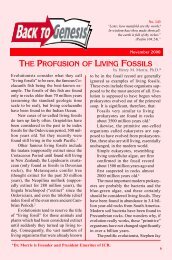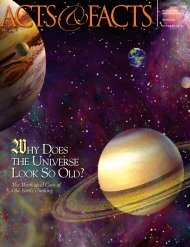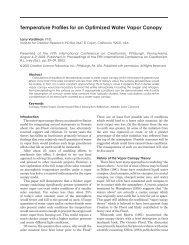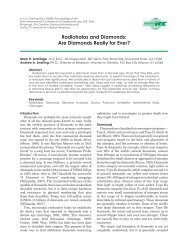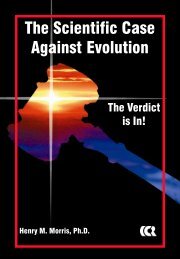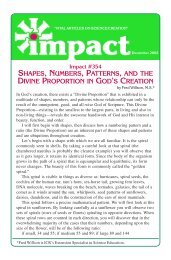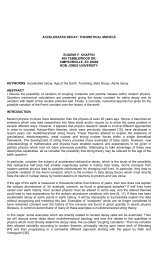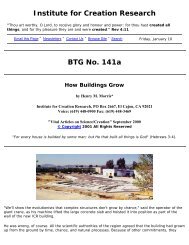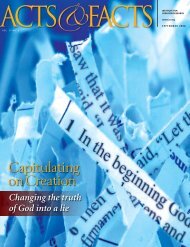Statistical Determination of Genre in Biblical Hebrew - Institute for ...
Statistical Determination of Genre in Biblical Hebrew - Institute for ...
Statistical Determination of Genre in Biblical Hebrew - Institute for ...
You also want an ePaper? Increase the reach of your titles
YUMPU automatically turns print PDFs into web optimized ePapers that Google loves.
Evidence <strong>for</strong> an Historical Read<strong>in</strong>g <strong>of</strong> Genesis 1:1–2:3 717situationality (a text is conveyed depend<strong>in</strong>g on the read<strong>in</strong>g situation<strong>of</strong> its readers), and <strong>in</strong>tertexuality (earlier texts, which are quotedor alluded to, <strong>in</strong><strong>for</strong>m the present text). For her discussion seeGroom [2003, pp. 131–138].16. Unlike Greek literature, <strong>in</strong> particular, Greek poetry, the <strong>Hebrew</strong>sdid not leave us a treatise on how to <strong>in</strong>terpret their poetry.17. W<strong>in</strong>ther-Nielsen [2002, p. 61; note 33] critiques Mey’s [1993, p. 281]contention that “the ways textual and dialogical constra<strong>in</strong>ts aremanipulated depend entirely on the contemporary conditions.”18. W<strong>in</strong>ther-Nielsen [2002] is quot<strong>in</strong>g Gibbs [1994].19. Sternberg, <strong>in</strong> his magnum opus, The Poetics <strong>of</strong> <strong>Biblical</strong> Narrative:Ideological Literature and the Drama <strong>of</strong> Read<strong>in</strong>g [1985], discussesthree issues that are germane to this study: (1) that <strong>in</strong> the Bible thereis a non-contradictory balance between its three characteristics:it is a literary masterpiece, it purports to be report<strong>in</strong>g historicalevents, and it is giv<strong>in</strong>g a clear ideological message; (2) that it iseasy to under-read the Bible but almost impossible to counter-readthe Bible. In other words, many times readers do not pick up all thesubtleties <strong>of</strong> the text, but the theological message is clear; (3) the<strong>Biblical</strong> authors believed that they were writ<strong>in</strong>g real history. SeeSection 7 <strong>of</strong> the present study <strong>for</strong> an extended discussion <strong>of</strong> thehistoriographical aspects <strong>of</strong> the Old Testament.20. See Dotan’s excellent <strong>for</strong>eword to Biblica Hebraica Len<strong>in</strong>gradensia[2001, pp. vii–x], <strong>in</strong> which he discusses the relative merits <strong>of</strong> thetwo extant Ben Asher texts: The Aleppo Codex and the Len<strong>in</strong>gradCodex.21. “Brick upon brick” refers to an arrangement <strong>of</strong> the l<strong>in</strong>es <strong>of</strong> text, <strong>in</strong>which one l<strong>in</strong>e is divided <strong>in</strong>to three textual blocks, the next l<strong>in</strong>e isdivided <strong>in</strong>to two blocks, the third l<strong>in</strong>e is divided <strong>in</strong>to three aga<strong>in</strong>,and so <strong>for</strong>th down the page. The result<strong>in</strong>g page resembles a brickwall, with the blocks <strong>of</strong> text as the bricks and the spaces betweenthe blocks as the mortar.22. Perhaps it was meant to honor the authors <strong>of</strong> these texts, Moses,Samuel, and David. But <strong>in</strong> the f<strong>in</strong>al analysis the reason escapes us.We can conclude, however, that the copyists do not clearly evidence


